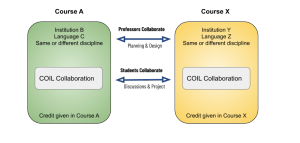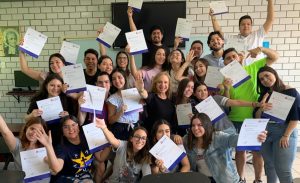What is COIL?
Para leer esta página en español, haga clic aquí.
Collaborative Online International Learning (COIL) is an approach that brings students and professors together across cultures to learn, discuss and collaborate as part of their class. Professors partner to design the experience, and students partner to complete the activities designed. COIL becomes part of the class, enabling all students to have a significant intercultural experience within their course of study.
COIL:
- Can be created in any discipline; interdisciplinary collaborations work well
- Encourage active student learning and teamwork
- Include an emphasis on cross-cultural interactions and understanding
- Can be 5-15 weeks long
- Are a graded activity in each participating class
- Can use any technology tools that serves the learning goals
As part of an existing class, the COIL component can take place throughout the entire course, or, more commonly, as a module that lasts for several weeks during the course. The minimum recommended length for a COIL module is 5 weeks.
Visually, COIL can be represented as:

What are the components of a COIL module?
Effective COIL collaborations follow a recognized progression through specific phases.
- The team building phase includes introductions and icebreakers, along with discussions and activities designed to help students get to know and feel comfortable working with one another online and across cultures.
- The next phase includes comparative discussions and organizing the project that teams of students will be working on. This phase prepares students for effective collaborative project work.
- The project phase is focused on the main activity for the collaboration. This is the time that students apply their knowledge, create something together or have substantive discussions around the topic of the collaboration.
- The final phase involves the presentation of work completed (in any format agreed upon by the collaborating professors), reflection on both the content of the module and the intercultural aspects of the collaboration, and concluding.

How is a COIL module developed?
COIL planning begins with collaboration between professors from different institutions who want to bring intercultural and global learning into their classes.
Professors work together to:
- Define student learning goals
- Determine the length of the interaction
- Design comparative and collaborative activities
- Select methodology and technology tools for collaboration
- Monitor student work and learning
Students work together to:
- Develop effective international/intercultural teams
- Discuss course assignments and content
- Complete a project-based activity as part of their coursework
- Reflect on both the academic content of the course and the intercultural exchange that takes place
There are many aspects that need to be discussed when developing a COIL module, such as language use, timing and calendars, harmonizing COIL module learning goals with overall course objectives, methods of assessment, classroom management issues, and technology tool selection. If you are interested in developing a COIL module for one of your classes and would like training and support on how to do this, the SUNY COIL Center has a number of professional development offerings that can help you.

Students in Mexico receiving COIL certificates